
Saturday, November 23, 2013
X-Prize - McKinsey Report
However the graphs are valuable.

This is the recent increase in prizes in recent years. However it includes more conventional prizes like the Booker and other arts prizes which have barely risen so it considerably understates the rise in technology prizes.
Labels: fi, Science/technology, X-Prizes
Friday, November 22, 2013
The Return Of the Airship
It appears that the world's first rigid airship since the 1930s will soon take to the skies for flight trials: and better still, this ship has a new piece of technology which could actually change the existing landscape and permit the leviathans of the skies to return.
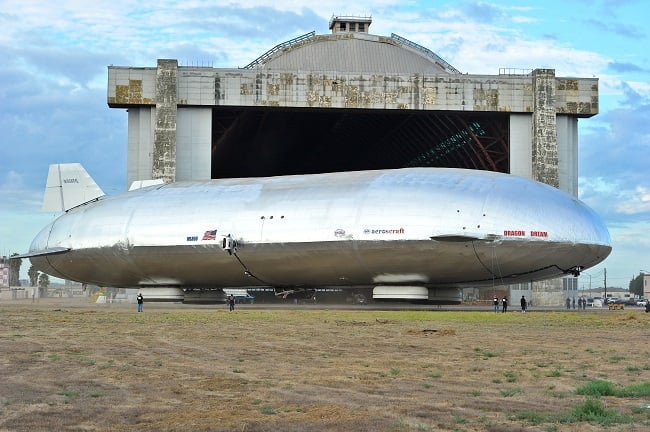 Rigid ships set to return to the skies - first time since August 1939*
Rigid ships set to return to the skies - first time since August 1939*-----------------------------------------------------
From the Register some time ago.
The great advantage of this sort of airship is that it can pump in its helium, and by becoming heavier than air, land vertically. That means it can compete in transportation, at least to remote areas and islands. Also that it can transport units to large for road or rail - the Register article mentions a 600 man battalion with heavy weapons but I am thinking, less extravagantly, of prefabricated houses or nuclear reactors.
-------------------------------------------------
Latest news is that the testing has been successful and that they expect to have it commercially available by 2016.
"Though the initial fleet will have 22 vehicles, he says there is a market for 2,500. NASA, the U.S. Air Force and the U.S. Department of Defense are betting on the Aeroscraft’s success, having given development funding to Aeros. “The demand’s so huge, and if we’ll be able to build today or bring to the market today 22 vehicles, it will be not enough,” Pasternak says. “It will be just not enough because people are so struggling with logistical issues.”
 and its beautiful.
and its beautiful.I wrote previously of how the R100 (the "capitalist airship") and therefore the future of airships was scrapped not because it was a failure but because it was a success which had worked perfectly. The 101 (the British government's "socialist airship") was a failure despite, or because of the ministry's total support whereas the R100 worked fine. This could not be allowed to be understood by the public so the R100 was sold for scrap.
Glad to see this technology has only been held up for 80 years by government parasites.
Labels: Government parasitism, Progress, Science/technology
Thursday, November 21, 2013
The Most Powerful Thing A Genuine Lobby Group Could Do Is Something a Government Sock Puppet Couldn't
A few years back, candidates wanting to stand as Labour/Co-operative Party joint candidates ran into a legal problem, despite the tradition of such joint candidates stretching back many decades. The Electoral Commission decided that, on close reading of election law, it was not legal for such joint candidates to have a logo appear next to their name on the party ballot.
Cue a flurry of election law changes to remedy the situation .....But in that mis-reporting is a germ of an idea which a pressure group could adopt.
A candidate for a political party could stand as a joint candidate, with a joint description and special logo on the ballot paper,* reminding voters at the most crucial key final moment before voting that this candidate is the one which gets their approval.
This idea of pressure group acting as minor political party in order to win coverage on the ballot paper and hence increase its electoral leverage – both to get candidates to agree to its policies and then to win votes for those candidates who do – is something aficionados of American politics may
recognise.
It is what US political parties such as the Working Families Party do, with a few wrinkles due to the different electoral law their but the same underlying purpose and method.
Imagine, for example, a group of environmental lobby groups setting up their minor political party and offering its ballot paper endorsement to candidates who back its policy.
Agree with them and you’re Labour? Fine, you get to stand as the Labour Party / Green Coalition joint candidate, so described on the ballot paper. Agree with them and you’re Lib Dem? Then it’s the Liberal Democrats / Green Coalition you appear as and so on.
This would simply extend the existing tactic of a pressure group asking candidates in a constituency their views on some set questions and then publicising the answers back to a relatively small number of voters signed up to the organisation in that constituency. Extend however in a crucial way.
Because by getting the answer as to who is most favoured on every printed ballot paper, it would take their message not to a small audience, but to the whole electorate.
Now that really would be a pressure group putting on the pressure.
--------------------------------------------------------
I think that is a pretty good idea, but not particularly for the LDs for reasons I explained in a comment I placed. It is clear from the way he describes it he is thinking of lots of right on politically approved pressure groups could pile on to the LDs forming a band wagon.
The main one, mentioned in another comment, is the Electoral Reform Society, which has long been the LDs in academia. However as I commented the LDs are no longer the most electable supporters of proportional representation. I would be quite comfortable with an ERS logo added to LDs or Greens in those areas where the Electoral Calculus said they were the main contenders and added to the UKIP logo where we are (& conceivably also a few Labour and Tories who had a genuine record of rejecting the whip to support PR).
With public support for PR running at about 70%:20% that could indeed be enough to make PR supporting parties a majority. I trust Mark would still support this, as a matter of principle, even though the main beneficiary would be UKIP.
The other advantage for opponents of overweening government (but disadvantage for LDs) would be that the Electoral Commission could never legally allow a government financed sock puppet to thus register itself as a party.
With almost every "Green" charity except Greenpeace, funded 70% by the EU and most of the rest by the British state no "group of environmental lobby groups setting up their minor political party and offering its ballot paper endorsement to" LibDems would be lawful.
But real organisations which aren't government funded fakecharities could. Who would the Migrationwatch Party or the Taxpayer's Alliance Party be likely to endorse? That's what I thought too,
-------------------------------------
Incidentally, with the typical commitment to free speech of the Pseudoliberal party my comment, when, after a undue delay, my comment appeared, mention of the government sock puppet problem had been removed ;-)
Another commenter had, quite independently, mentioned the Electoral Reform Society, which is not surprising.
Labels: British politics, UKIP
Wednesday, November 20, 2013
Big Engineering 55 Rail Braking
The previous arguments that it made economic sense were ludicrous and have had to be dropped. At about £80 bn, if it had to make a 10% return on capital as is normally expected that would cost £300 per ticket plus the natural running cost - this clearly does not make economic sense.
So back to overcrowding.
Rail's problem is that while road vehicles only have to stay a couple of car lengths apart, trains have to be about a mile apart. This is because the stopping distances are so much longer - rails being slipier than tarmac and carriages much heavier. For a long time John Redwood has been saying rail should learn from bus technology and build much lighter vehicles. This is also obviously far more fuel efficient. He is right on that . I also think we should be building automated rail which, by allowing single carriage units running 24/7 would increase capacity.
But here is another idea. A new magnetic braking system:
Here is a summary of the changes needed:
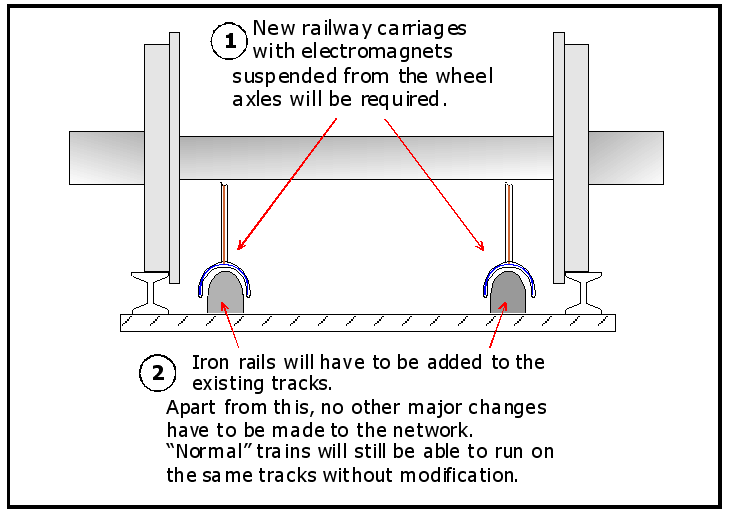
The minimum safe time interval between high speed trains using the same length of track is about 3 minutes, but for a car travelling at the same speed it is only a few seconds.
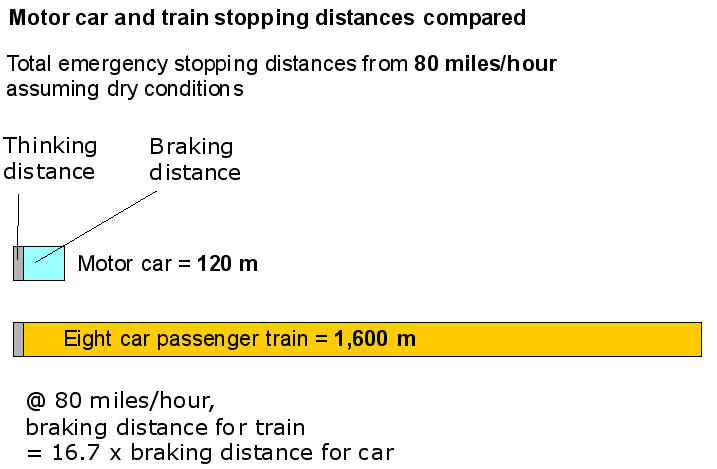
They offer several advantages: Wear on the track is minimal and acceleration, braking and fuel economy all improve,
but these benefits are outweighed by the high track building costs.
The braking and acceleration benefits of Maglev are maintained, but Magtrc’s levitation effect is not sufficient to support the weight of the train.
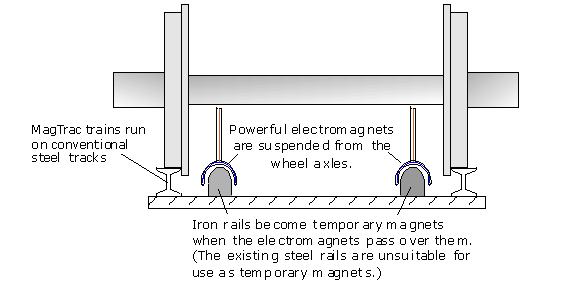
A. Iron rails are better at amplifying the strength of the electromagnets but they rapidly lose their magnetism when the train passes. This eliminates the problem of steel cans and other ferromagnetic junk sticking to the rails.
We will build the Magtrac principle up in stages
1.1 The key concept
First we consider what happens when an electric current is passed through two solenoids resting on a soft iron bar.
[A solenoid is a cylindrical coil of wire that acts as a magnet when an electric current passes through it. The magnetic effect is weak if the interior of the solenoid is filled with air, but strong if the air is replaced by iron.]
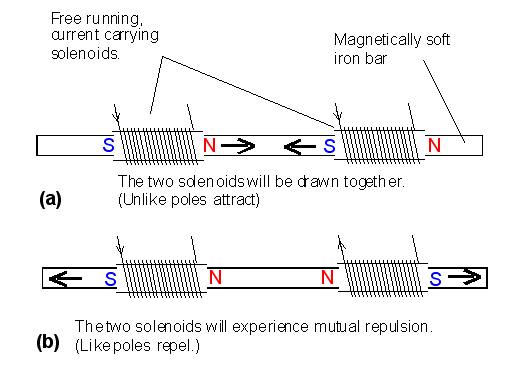
We can't cheat nature by switching the magnets off and then moving them apart because when we switch the magnets back on again work has to be done against the back EMFs as the magnetic fields are rebuilt.
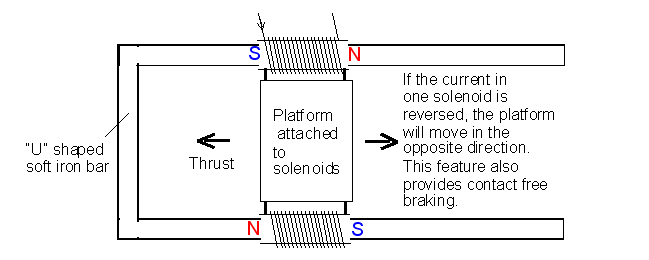
(ii) “Half solenoids” that can “jump” from one iron bar to the next are used.
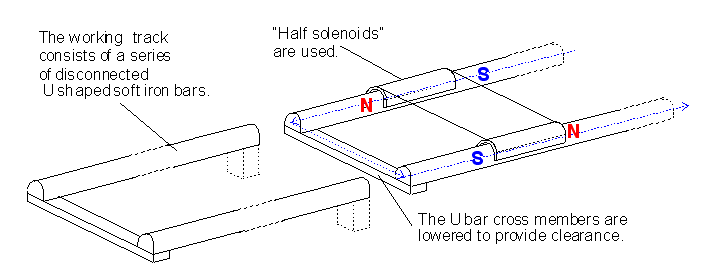
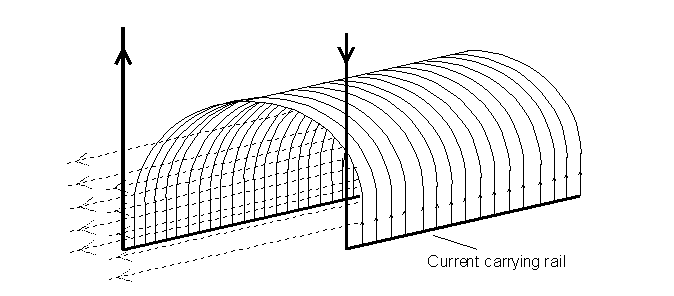
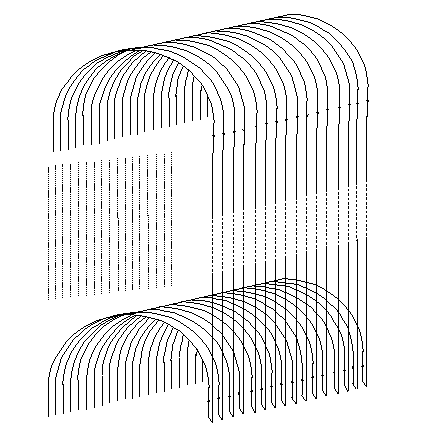
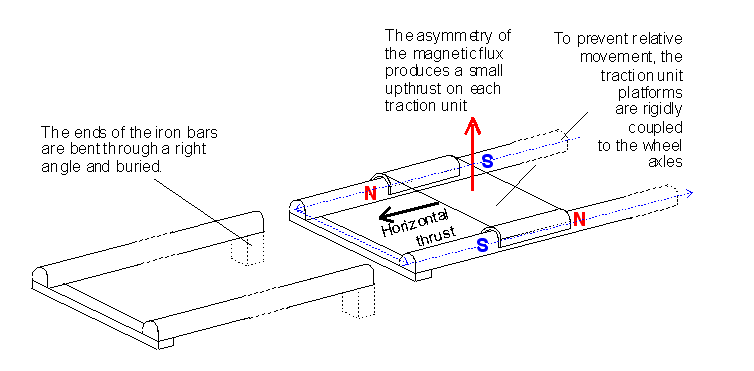
The up thrust is a useful bonus but it cannot be relied upon to support the weight of the train because it varies with the current passing through the half solenoids.
The up thrust on the train produces an equal and opposite down thrust on the iron rails. This improves the friction grip between the rails and underlying sleepers.
This is for intellectual property protection reasons.
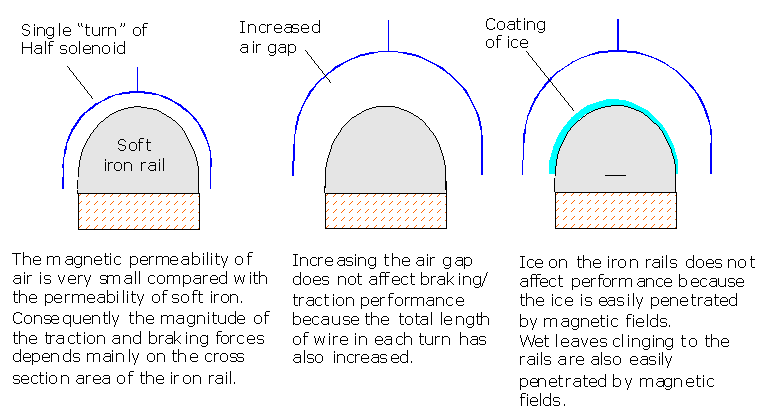
When an iron rail goes through a magnetisation-demagnetisation cycle, a small amount of heat is generated. (Hysteresis loss.) This will help to melt any ice or snow in winter.
2.1 Superconducting shieldsFor superconducting systems the runners are lodged in cold chambers. Magnetic flux cannot penetrate a sheet of superconducting material, so by lining the out facing walls of the cold chambers with superconducting material, magnetic flux shields can be created.
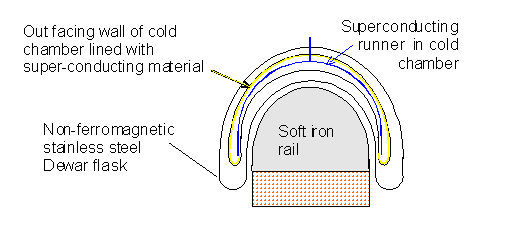
To prevent the outer faces of the Dewar flasks icing up in winter they can be fitted with heating elements to keep their temperature just above 0oC.
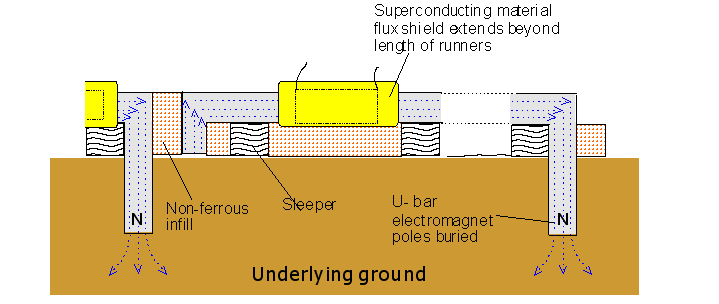
New designs of cryocoolers (low temperature refrigerators) created for use with rolling stock are published on our superconductors and cryocoolers web page.
Copper is easy to handle when manufacturing the half solenoids and has the safety bonus that it can still be used for effective braking, even if the hydrogen cooling system fails.
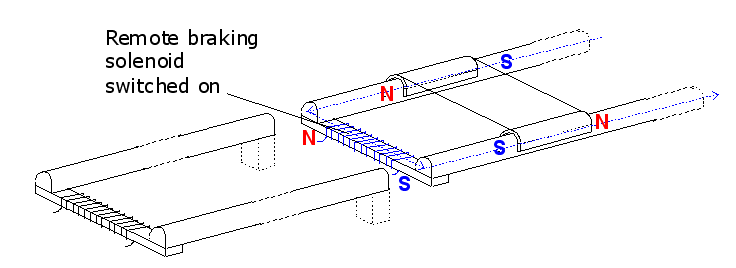
Braking solenoid on: Axle mounted N repelled by Magtrac rail mounted N. Braking power is generated.
The elimination of friction as the primary source of braking, combined with the reduced wheel on track loading, thanks to the Magtrac up-thrust, will significantly reduce train noise.
Magtrac eliminates the squealing of friction brakes and the vibrations caused by uneven wear on the steel tyres resulting from friction braking.
Labels: Big Engineering, British politics, Government parasitism, Science/technology
Tuesday, November 19, 2013
Why Scotland is Not Like Scandinavia
In that the SNP are absolutely right. If we had non-EU world average growth (6%) we would be twice as well off by 2025.
And if the SNP were going to do it I would be for them. Indeed back when Jim Mather was their intellectual light I thought they at least intended to do so.
The SNP have had a term and a half to produce growth and sweet absolutely nothing. Well nothing positive. They have wasted billions on windmills and committed us to be "100% renewable by 2020" which is a commitment to economic collapse and deaths. When their Green partner in the Yes campaign promised that separation would mean the joys of recession for at least 10 years and hopefully forever, they said not one word in disagreement. They still haven't. Their numerous promises of lower taxes and higher government spending do not suggest that economic competence is anywhere on their radar.
The latest SNP spokescritter wheeze is to say that high taxes and government interference works in Scandanavia. Lesley Riddoch was squeaking this line last night. Well no they have a wrinkle our government doesn't. Their governments spend relatively effectively on doing things and don't regulate wealth creation out of existence,
Why does Sweden have so many billionaires ?
Billionaires per capita.
Here's the top 10 (number of billionaires/estimated population):
1. Monaco (3/35,427)
2. St. Kitts and Nevis (1/53,051)
3. Guernsey (1/65,573)
4. Hong Kong (39/7.1 million)
5. Belize (1/356,600)
6. Cyprus (3/1.1 million)
7. Israel (17/7.8 million)
8. Singapore (10/5.2 million)
9. Kuwait (5/2.8 million)
10. Switzerland (13/7.9 million)
12. Sweden (14 billionaires, population 9.56 million)
But one country stands out on the list: Sweden.
How does a famously socialist and left-wing country like Sweden get so many billionaires ?
Why are billionaries a good sign ? Because usually they created a great company.....The good news about Sweden is that it’s exactly that kind of place. High taxes go to finance cheap health care and education, an excellent system of public transportation, and relatively generous subsidies to low-income households that keep the poverty rate and inequality low. But they haven’t stopped Swedish entrepreneurs from building giant firms like H&M, Ikea, and Tetra Pak.
The Scandinavian success stories show that great companies can be born and innovate amid generous welfare states, they do have some cautionary tales for left-wing thinking. The Swedish tax code was substantially reformed in 1990 to be friendlier toward capital accumulation, with a flat rate on investment income. Sweden has no taxes on inheritance or residential property, and its 22 percent corporate income tax rate is far lower than America’s 35 percent. Even after spending cuts by the current center-right government, the Swedish public sector is still about half the total economy (much higher than here), but the taxes that finance it fall more heavily on consumption and less on business investment than in the U.S.
Sweden also has a relatively lightly regulated economy. There are rules about public health and environmental protection, of course. But Sweden is arguably further down the neoliberal path of dismantling purely economic regulations than the U.S. In Stockholm, for example, taxi fares are completely unregulated and for-profit charter schools are common. All things considered, international surveys rank Sweden as a place where it’s easy to do business. Within the U.S., surveys show that licensing rules rather than tax rates are the main driver of local business-friendliness.
If you have a high income tax rate but low corporate, property and capital gains taxes and light regulations for other aspects of business then you can still generate a lot of billionaires.
------------------------------------------------------------
Norway cuts hundreds of km of tunnels at £4m per km whereas the SNP, with support from the other useless Holyrood parties, spent £2,300m on a new Forth bridge (8 times more than it should have been) and said that a £30m tunnel would have cost £6,600m if built by them.
Finland, as well as Sweden, are willing to use nuclear power.
Iceland, in proper free enterprise style, let their banks go bust.
Norway and Iceland refuse to be part of the EU zero growth zone.
Yes the Scandinavian countries prove that with only a bit of common sense and very little free marketism it is possible to do rather well. Estonia, which started much poorer because it had been in the USSR went ideologically free market and is thus doing remarkably well.
But none of the current Holyrood parties have any commitment to Scandinavian common sense. All are committed to massive state parasitism. Worse than that, our media institutions are also committed to it. Not one paper or broadcaster was willing, at any time, to report that the 7/8th of the cost of the Forth Bridge is either state parasitism or simple theft.
Government economic parasitism (ie taxes) is important (it costs 50% of our gdp, possibly 55% in Scotland) but regulatory parasitism is worse in that it costs at least another 100% of current gdp, and the latter is the bit the Swedes have beaten.
We wouldn't have to be run that well to achieve growth that would end all our problems (Zimbabwe recently managed 9.3%) either in Holyrood or Westminster, but it is absolutely certain that the Holyrood parties have neither the competence nor desire to do so.
Labels: British politics, Government parasitism, Scottish politics
Monday, November 18, 2013
Ultra Automated Transport Takes Another Step
The same company is now using the same equipment to provide driverless cars (on rail) to provide a public transport system in Milton Keynes http://phys.org/news/2013-11-uk-town-deploy-driverless-pods.html
This is my previous article on the subject. The Ultra system is also in use at Heathrow now. But not Glasgow.
Labels: Glasgow, Science/technology, Scottish politics
Sunday, November 17, 2013
More Current Than When He Wrote It
Rudyard Kipling
The Servant When He Reigneth
Three things make earth unquiet And four she cannot brook The godly Agur counted them And put them in a book -- Those Four Tremendous Curses With which mankind is cursed; But a Servant when He Reigneth Old Agur entered first. An Handmaid that is Mistress We need not call upon. A Fool when he is full of Meat Will fall asleep anon. An Odious Woman Married May bear a babe and mend; But a Servant when He Reigneth Is Confusion to the end. His feet are swift to tumult, His hands are slow to toil, His ears are deaf to reason, His lips are loud in broil. He knows no use for power Except to show his might. He gives no heed to judgment Unless it prove him right. Because he served a master Before his Kingship came, And hid in all disaster Behind his master's name, So, when his Folly opens The unnecessary hells, A Servant when He Reigneth Throws the blame on some one else. His vows are lightly spoken, His faith is hard to bind, His trust is easy broken, He fears his fellow-kind. The nearest mob will move him To break the pledge he gave -- Oh, a Servant when he Reigneth Is more than ever slave!
Labels: Errata, Government parasitism, Rise of modern fascism